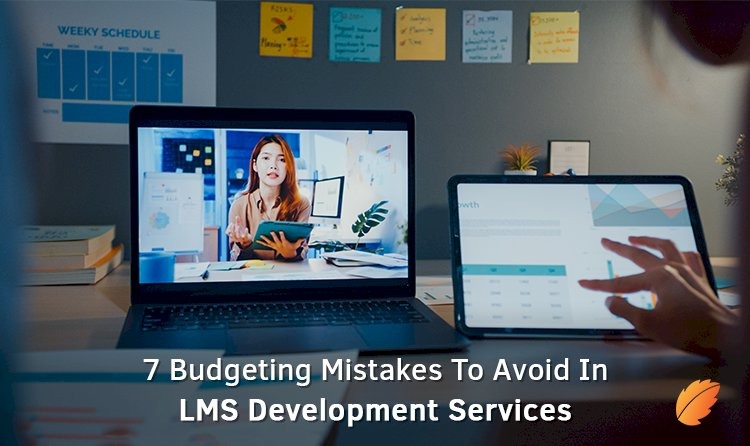7 Budgeting Mistakes To Avoid In LMS Development Services
Since many companies are shifting to LMS for training, there's little doubt about the number of investments going down the LMS development services lane.
A corporate e-learning app development should consider various parties' needs, such as employees, stakeholders, investors, and many more. But this is not a step to discontinue your efforts. Training companies need to prioritize clients and identify their primary and secondary requirements from LMS.

Integrating the top features for Learning Management Systems should be the goal of the management to meet everyone's expectations. There is a greater need for flexibility to accommodate diverse objectives for training. Therefore, a much urgent requirement is to invest prudently and have the best outcomes from LMS development services.
The best ROI comes to those who plan ahead of time. It fits perfectly in the case of LMS training modules.
Let's dig in.
1. Vague Target Market-
Various training organizations are unsure about their target segment's number, type, and personas. The absence of proper research and systematic segregation of the target audience into defined market segments with similar characteristics leads to a fuzzy picture.
These companies have no clue about the quality LMS features for students who are primarily employees. They have just scratched the surface layer and, therefore, pour too generously into the funds.
Catering to the clients' expectations leads to overbudgeting. The companies have no knowledge reservoir to tap regarding the tech stack, level of support, and active deployment process.
Some training organizations go as far as entrusting the job to a new learning management software development.
Therefore, it's better to do the homework well and research well in advance on the requirements and the means to fulfill them without going over the budget.
2. Inappropriate Choice of Features-
The client organizations need to deploy global compliance training programs. In order to be more acceptable in various regions, the LMS should host a range of in-built features such as multilingual support and advanced reporting, and, last but not least, certification management.
LMS mobile app development should have a user-friendly UI to navigate seamlessly through the app. Most companies fail to provide these features to the best of their financial capacities.
3. Getting it Right through Robust Vendor Support-
As a 21st century organization investing in LMS mobile app development services, you should never underestimate the power of vendor support and maintenance. The challenges don't come knocking on the door. Therefore, a vendor's expertise is highly appreciated to curb any future financial crisis.
4. Overlooking the Learning Curve-
The biggest mistake you can make before going to an LMS development company is not deciding the learning period of the LMS program. It takes considerable time for the employees and clients in your organization to learn relatively new technology and get habitual of it. Even if your LMS is the most efficient piece of tech in your team's hand, it is useless if they can't operate it.
If so, it may take months to master the tool and use it to your organization's advantage. Be prepared for the budgetary setback of overlooking the learning curve in the long term.
5. Clarity on Pricing Structure-
Plan a meeting to discuss the complete list of costs involved in the LMS mobile app development with your provider. Many times, there are various payment and deployment options involved in LMS with added costs.
The training company should discuss these possible costs in detail before signing an agreement with the LMS development company.
For example, vendors can provide hosting options with a monthly subscription fee. Most of the vendors ask for upfront expenses to initiate the project.
6. Integration Challenges-
The LMS may be the best you have had until now, but it might still not be best suited to your system. It will help if you have an ideal level of support and complete clarity on the pricing structure in advance. The existing system's database should be easily transferrable into the new LMS and gel-well with it. If not, you will have to cut your pocket again for replacement tools or add-ons which surpass your budget.
This situation will also divert your workforce to make the new software work efficiently.
7. Maintenance and Support Costs-
LMS budget should account for two primary maintenance charges- the system and the content. LMS development services should keep the system up-to-date to stay on pace with technological advancement. It curbs competition and makes way for improvements over time.
Similarly, the training content never remains the same. There are always better tools and resources coming to revise, expand and update the knowledge repository to teach your trainees. You might need to repurpose additional assets such as old templates.
One can always cover the charges by taking a small monthly amount from the clients. Still, it is always the providers' responsibility to cover the maintenance charges.
Conclusion-
New LMS brings lots of queries and anxieties about its suitability and maintenance in the long and short run. But, this guide can help you avoid the fundamental budgeting mistakes for LMS development services. In short, this is a prep talk about getting you moving towards a better and more informed LMS decision.
Consagous Technologies is a leading LMS mobile app development services provider in LA, USA. We help your research well and identify must-haves for a productive LMS. Get our professional assistance.
Original Source:
https://www.consagous.co/blog/7-budgeting-mistakes-to-avoid-in-lms-development-services
Comments
Post a Comment